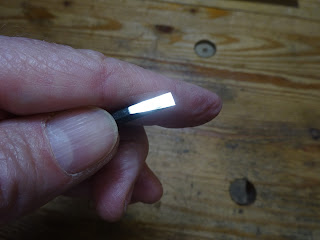A couple weeks ago I went to a tool show put on by my tool collectors organization, PAST. In addition to the conversations with like-minded people, there are always great things to see and play with. But I usually don't come home with anything because I just don't have the space to be a tool collector. My tools are user tools, although I will admit that I have more than I need.
Anyway, I bought a couple things at the show. The first, for a whopping $8, was a nice moving filletster plane from Sandusky Tool. Co. And second, a great book (for $3) titled "How to Build Shaker Furniture" written by Thomas Moser and with measured drawings by Chris Becksvoort.
 |
| Sandusky #68 moving filletster plane |
 |
| The front end |
I did a quick search online and found a 1925 Sandusky catalog showing a #68 plane as a moving filletster. And that's why I'm spelling it like that, when mostly I see and hear it said as "fillister". BTW, I doubt this plane dates from 1925, but it's probably something close to that. The only difference I can see between my plane and the one pictured in the 1925 catalog is that my wedge has the back of the finial relieved so the back end of the iron can be tapped with a hammer if it gets as short as the wedge.
This plane has a nice depth stop, but is missing the nicker. I'll try to make one someday soon. The recess for the nicker iron is dovetailed two ways. Vertically, the slot gets narrower as you get closer to the sole. And the recess gets wider as it gets deeper into the plane body. So it should just be a matter of filing a piece of steel for a good fit.
 |
| The depth stop |
 |
| It's fixed in its recess with a fat wood screw |
 |
| Here, I'm pointing to where the nicker iron should be |
The fence of the plane is made of an unknown hardwood - nothing special, I think - and it has two rectangular brass washers (not sure if that's the proper term) that the big fat wood screws bear against.
 |
| The fence |
 |
| Removed and showing the big screws |
 |
| Here's one of the brass "washers" |
The side of the fence that meets the plane's sole has marks from many years of contact with the plane's iron. I'd love to know if it was normal for a manufacturer to make a cutout here or if it just gets like this from normal use.
 |
| Showing the "recess" where the plane's iron contacts the fence |
Finally, the iron and wedge are in pretty good shape. I was able to cut a 1/2" wide rabbet without even touching up the iron. I'm sure it'll be even nicer once the iron is tuned up. Funny thing with this iron is that it's edge is not even close to straight - it's got a camber on it. I didn't measure it, but it's probably about 1 1/2" wide. The iron is skewed in the plane, so its edge is at an angle to the sides. But the cutting edge is not straight.
 |
| The wedge and iron |
 |
| Look at the camber on that iron! |
Maybe the iron is just relieved where it is almost never used (near the 3 inch mark on the ruler in above picture). It's hard to imaging needing a rabbet more than 1" wide! If anybody knows something more about that I'd love to hear about it in the comments.
The second item I picked up was this 1977 book from Thomas Moser. This looks like a tremendous book and I can't wait to dig into it much deeper and maybe even make a few of the projects.
 |
| Hardback cover, too |
 |
| An example of one of the dozens of projects in the book |
Well, that's all for now. My woodworking has been slowed lately with some knee problems, so I've not been posting regularly. I'm going to have the knee replaced in a few weeks and that'll for sure have me out of commission for a while.































